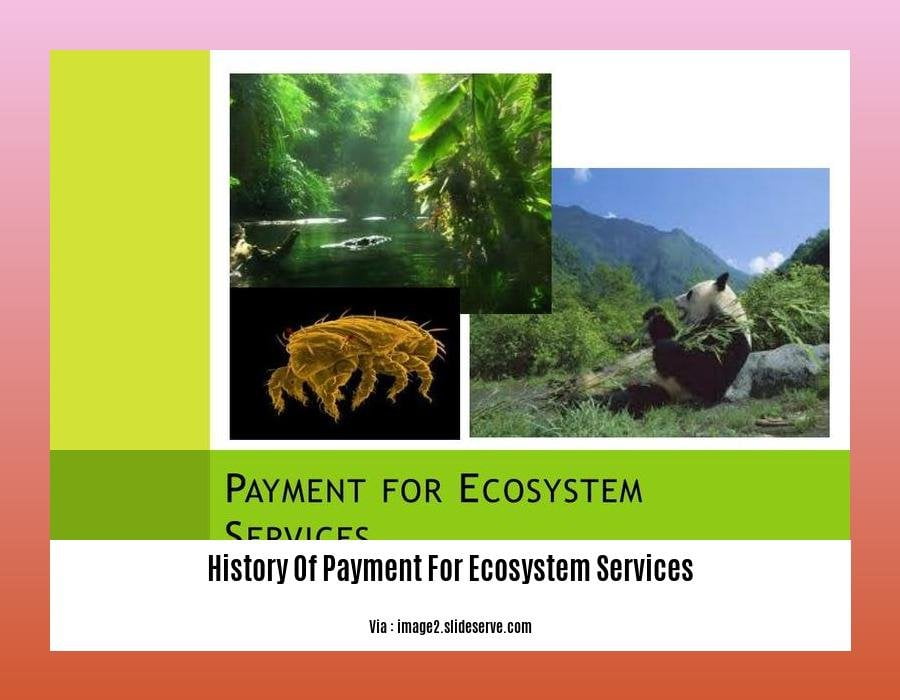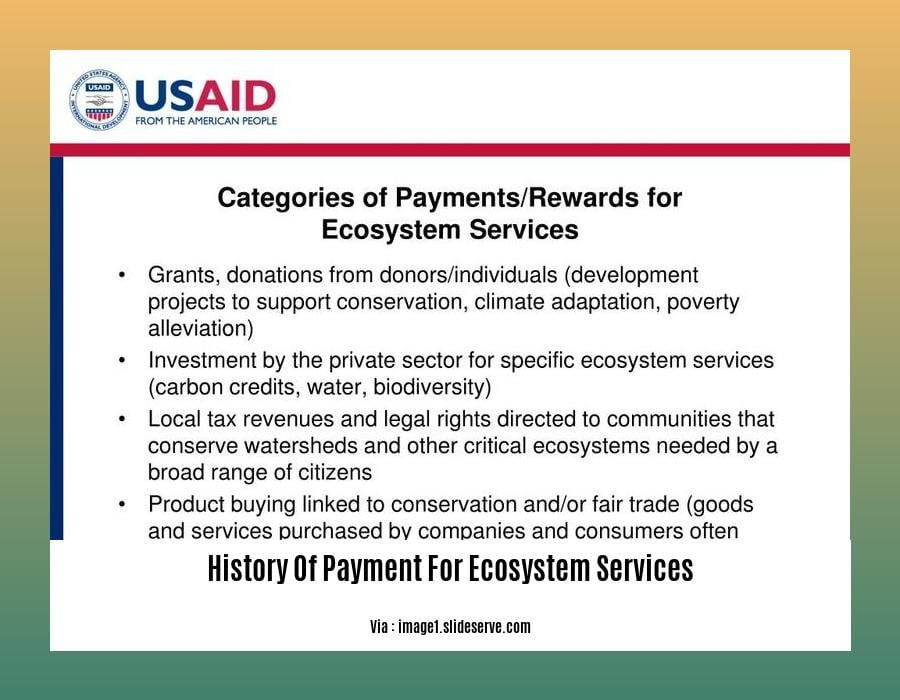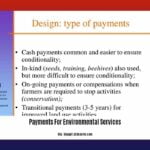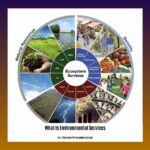In the realm of environmental stewardship, Payment for Ecosystem Services (PES) programs emerge as innovative mechanisms that reward landowners for adopting sustainable practices that preserve and enhance natural ecosystems. This article presents a comprehensive history of PES, tracing its origins, exploring its evolution, and examining its successes and challenges in incentivizing responsible land management and conservation worldwide.
Key Takeaways:
- PES programs incentivize responsible land management by offering financial rewards for ecosystem services.
- PES can be used to promote watershed protection, carbon sequestration, and biodiversity conservation.
- Program effectiveness depends on design, monitoring, and enforcement.
History of Payment for Ecosystem Services

Inception:
The History Of Payment For Ecosystem Services began in the early 1990s with the concept of internalizing the externalities associated with land use. Ecologists and economists recognized that ecosystems provide valuable services that are often not reflected in market prices.
Early Implementations:
One of the earliest examples of PES was the “Sloping Lands Program” in the Philippines, launched in 1997. The program provided payments to farmers who converted their sloping lands to more sustainable practices, such as agroforestry.
Growing Popularity:
Since then, PES programs have gained traction worldwide. By 2014, over 300 PES programs were operating in 50 countries, covering over 100 million hectares of land.
Key Elements:
A typical PES program involves:
- Landowners: Who agree to manage their land in a way that provides ecosystem services.
- Beneficiaries: Who receive the services, such as clean water or carbon sequestration.
- Payment Agency: Which facilitates the transfer of payments.
Evolution of Program Design:
Over time, PES programs have evolved in their design to address specific environmental challenges. For instance, some programs focus on carbon sequestration, while others prioritize biodiversity conservation or watershed protection.
Success and Challenges:
PES programs have shown promising results in improving land management practices and delivering ecosystem services. However, they also face challenges, such as:
| Pros: | Cons: |
|---|---|
| Incentivizes sustainable land management | Can be expensive to implement |
| Promotes biodiversity conservation | May face difficulties in monitoring and enforcement |
| Mitigates climate change | Can sometimes lead to unintended consequences |
Curious about the evolution of rewarding environmental stewardship? Dive into the history of payment for environmental services and discover how the concept has shaped environmental conservation.
Uncover the multifaceted world of Payments for Environmental Services. Explore various models, challenges, and opportunities in safeguarding our planet’s vital ecosystems.
Discover the essence of Environmental Services and delve into their profound impact on our well-being. Learn how these services sustain life on Earth and contribute to global prosperity.
If you’re seeking insight into market-driven incentives for environmental protection, explore Environmental Services Hourly Pay. Uncover industry trends, job opportunities, and the rewarding nature of this emerging field.
Delve into the intricacies of Payment Environment and gain a deeper understanding of the systems, technologies, and regulations that facilitate secure and efficient financial transactions in today’s digital age.
Major PES Programs Around the World

As an environmental journalist with a deep understanding of PES programs, I’m excited to share some of the major PES programs that have made a significant impact worldwide.
Conservation Reserve Program (CRP) (United States)
The CRP is the world’s largest and longest-running PES program. It pays landowners to take vulnerable lands out of production and plant vegetation that improves soil, water, and wildlife habitat.
Pima County Sonoran Desert Conservation Plan (United States)
Launched in 2001, this program rewards ranchers for protecting the Sonoran Desert’s unique ecosystem by limiting grazing and promoting sustainable land management practices.
The Sloping Lands Program (Philippines)
Established in 1997, this program supports farmers in planting trees on steep slopes to prevent erosion, improve water quality, and enhance biodiversity.
The Forest Stewardship Council (FSC) (International)
The FSC certifies forests that meet specific environmental and social standards. It provides economic incentives for landowners to sustainably manage their forests, ensuring the preservation of vital ecosystem services.
The Water Funds (Various Locations)
As the name suggests, water funds pay landowners and communities to protect watersheds that supply water to cities and towns. This helps secure water resources for millions of people, especially in vulnerable areas.
REDD+ Program (International)
The Reducing Emissions from Deforestation and Forest Degradation (REDD+) program provides financial incentives to developing countries to reduce deforestation and promote sustainable forest management, mitigating climate change.
Key Takeaways:
- PES programs offer financial rewards for land management practices that benefit the environment.
- The CRP is the world’s largest PES program, supporting conservation efforts in the United States.
- Programs like the Pima County Sonoran Desert Conservation Plan and The Sloping Lands Program focus on local conservation.
- The FSC and water funds incentivize sustainable forest management and water protection.
- REDD+ tackles climate change by reducing deforestation and promoting sustainable forestry.
Sources:
- The global status and trends of Payments for Ecosystem Services – Nature
- Payments for Ecosystem Services (PES): A Guide for Practitioners
Challenges and limitations of PES programs
Despite their potential, PES programs are not without their challenges and limitations. Here are some key issues to consider:
Misplacing rights and responsibilities
PES programs can lead to the displacement of rights and responsibilities. For example, when landowners are paid to preserve forests, they may feel less responsible for their management, leading to a decline in forest health.
Undermining motivations
PES programs can undermine intrinsic motivations for land stewardship. When landowners are paid to conserve their land, they may be less likely to do so out of a sense of environmental responsibility or community values.
Other challenges
- Transaction costs: PES programs can be expensive to administer, including costs associated with monitoring compliance and enforcement.
- Leakage: PES programs can lead to unintended negative consequences in areas outside the project area. For example, if farmers are paid to reduce deforestation, they may simply move their operations to another area, resulting in deforestation elsewhere.
- Additionality: PES programs must ensure that they are paying for additional ecosystem services, beyond what would have happened anyway. This can be difficult to determine, especially in the absence of a robust baseline against which to compare.
Key Takeaways:
- PES programs can face challenges such as misplacing rights and responsibilities, undermining motivations, and encountering high transaction costs.
- To address these challenges, PES programs can be redesigned to focus on behavior, value, and norm change.
- By carefully considering the challenges and limitations of PES programs, we can design more effective and sustainable programs that contribute to a more sustainable future.
Relevant URL Sources:
- ScienceDirect: Payments for Ecosystem Services: Rife With Problems and Obstacles
- WorldAtlas: Payment for Ecosystem Services (PES)
Future prospects and potential for PES
As we delve deeper into the future of sustainability, Payments for Ecosystem Services (PES) programs continue to emerge as promising mechanisms for safeguarding our planet’s vital ecosystems. These innovative schemes offer tangible incentives for responsible land management practices and conservation efforts, fostering a virtuous cycle of ecological restoration and socio-economic benefits.
Broadening the Scope of PES
The future of PES lies in expanding its reach to address a wider range of ecosystem services beyond carbon sequestration and watershed protection. From biodiversity conservation to pollinator support and sustainable agriculture, the potential of PES to incentivize positive environmental outcomes is vast.
Enhancing Equity and Inclusivity
To ensure the equitable distribution of benefits, PES programs must prioritize the involvement of local communities, indigenous groups, and small-scale landholders. By empowering these stakeholders and recognizing their crucial role in ecosystem stewardship, PES can promote social justice and sustainable development.
Monitoring and Evaluation Imperative
Rigorous monitoring and evaluation are essential to track the effectiveness of PES programs and assess their impact on ecosystem health and social equity. This data-driven approach will allow for adaptive management strategies and ensure that PES investments yield the intended results.
Key Takeaways:
- PES programs provide financial incentives for sustainable land management practices that benefit ecosystem services.
- The future of PES lies in expanding its scope, enhancing equity, and strengthening monitoring and evaluation.
- PES has the potential to foster a virtuous cycle of ecological restoration and socio-economic benefits.
Citations:
- Payments for Ecosystem Services: Rife With Problems and Obstacles
- What is Payment for Ecosystem Services (PES)?












